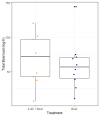Co-Exposure with the Herbicide 2,4-D Does Not Exacerbate Batrachochytrium salamandrivorans Infection in the Italian Crested Newt (Triturus carnifex)
- PMID: 40564329
- PMCID: PMC12189190
- DOI: 10.3390/ani15121777
Co-Exposure with the Herbicide 2,4-D Does Not Exacerbate Batrachochytrium salamandrivorans Infection in the Italian Crested Newt (Triturus carnifex)
Abstract
Amphibians face a multitude of threats and therefore make a prime example of the current biodiversity crisis. Multiple amphibian stressors in anthropogenic landscapes include infectious diseases and agrochemicals. Synergic effects between these stressors may increase the negative impact of infections on amphibian health. In a 56-day trial, we assessed the impact of co-exposure to the herbicide 2,4-dichlorophenoxyacetic acid (2,4-D) and the pathogenic fungus Batrachochytrium salamandrivorans (Bsal) on infection parameters (infection intensity and disease severity) and health (body condition and telomere length) in Italian crested newts (Triturus carnifex). Twenty days post-inoculation with Bsal, newts were either exposed to 2,4-D for 12 days or not exposed (control). Most newts developed high infection loads that steadily increased towards the end of the trial. While body condition was negatively correlated with pathogen burden, only one out of 23 animals died. Telomere length remained unaffected by the pesticide and the pathogen. The 2,4-D treatment did not exacerbate Bsal infection. Most newts survived almost two months with significant pathogen loads; thus, even in a pesticide-infested environment, T. carnifex could be an important long-term Bsal reservoir for co-occurring species on the Italian peninsula, a urodele diversity hotspot.
Keywords: agrochemicals; amphibian conservation; chytridiomycosis; emerging infectious diseases; newts; pollution.
Conflict of interest statement
The authors declare they have no conflicts of interest that could be perceived as prejudicing the impartiality of the research reported. The authors affirm that they have no relevant financial or non-financial interests to disclose. This statement ensures transparency and maintains the integrity and trust of the scientific community in the findings and conclusions presented in this study.
Figures



Similar articles
-
Effectiveness and safety of vitamin D in relation to bone health.Evid Rep Technol Assess (Full Rep). 2007 Aug;(158):1-235. Evid Rep Technol Assess (Full Rep). 2007. PMID: 18088161 Free PMC article.
-
Systemic pharmacological treatments for chronic plaque psoriasis: a network meta-analysis.Cochrane Database Syst Rev. 2021 Apr 19;4(4):CD011535. doi: 10.1002/14651858.CD011535.pub4. Cochrane Database Syst Rev. 2021. Update in: Cochrane Database Syst Rev. 2022 May 23;5:CD011535. doi: 10.1002/14651858.CD011535.pub5. PMID: 33871055 Free PMC article. Updated.
-
Active body surface warming systems for preventing complications caused by inadvertent perioperative hypothermia in adults.Cochrane Database Syst Rev. 2016 Apr 21;4(4):CD009016. doi: 10.1002/14651858.CD009016.pub2. Cochrane Database Syst Rev. 2016. PMID: 27098439 Free PMC article.
-
Different corticosteroids and regimens for accelerating fetal lung maturation for babies at risk of preterm birth.Cochrane Database Syst Rev. 2022 Aug 9;8(8):CD006764. doi: 10.1002/14651858.CD006764.pub4. Cochrane Database Syst Rev. 2022. PMID: 35943347 Free PMC article.
-
Systemic pharmacological treatments for chronic plaque psoriasis: a network meta-analysis.Cochrane Database Syst Rev. 2017 Dec 22;12(12):CD011535. doi: 10.1002/14651858.CD011535.pub2. Cochrane Database Syst Rev. 2017. Update in: Cochrane Database Syst Rev. 2020 Jan 9;1:CD011535. doi: 10.1002/14651858.CD011535.pub3. PMID: 29271481 Free PMC article. Updated.
References
-
- IUCN SSC Amphibian Specialist Group Triturus cristatus. The IUCN Red List of Threatened Species. [(accessed on 11 December 2024)]. Available online: https://www.iucnredlist.org/
-
- Brunner J.L., Olson D.H., Gray M.J., Miller D.L., Duffus A.L. Global patterns of ranavirus detections. Facets. 2021;6:912–924. doi: 10.1139/facets-2020-0013. - DOI
-
- Lisachova L.S., Lisachov A.P., Ermakov O.A., Svinin A.O., Chernigova P.I., Lyapkov S.M., Zamaletdinov R.I., Pavlov A.V., Zaks S.S., Fayzulin A.I. Continent-wide distribution of CMTV-like ranavirus, from the Urals to the Atlantic Ocean. Ecohealth. 2025;263:e5949. doi: 10.1007/s10393-025-01703-3. - DOI - PubMed
Grants and funding
LinkOut - more resources
Full Text Sources

